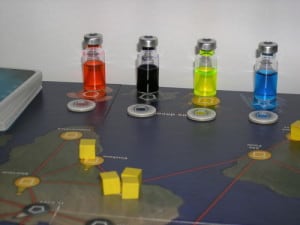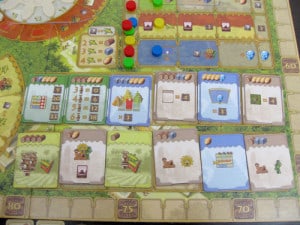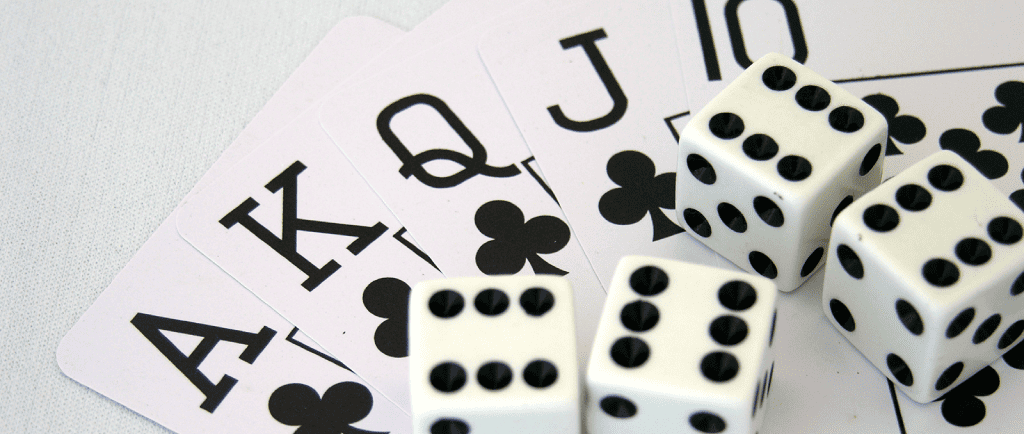
In my last article, I gave an overview of the various high level elements one should keep in mind when designing games. Today I’m going to start delving deeply into the first element with the end of the game: the goal.
Eric Redekop pointed out in a comment to the introductory article that games don’t necessarily need goals for players. He’s absolutely right–many games, like SimCity, offer a fun experience for players without explicitly telling them what to do. Still, I like having player goals for a couple of reasons:
They help guide player behavior. Not all players need guidance, but many people play games because they want to solve specified problems. They like rules and want artificial incentives. Giving them a goal helps them enjoy themselves.
They help structure the experience. When I’m working on a game, I’m not just throwing together mechanics. I’m trying to sculpt an experience. And goals can really help shape that experience, controlling the game length and keeping things consistent between players and plays.
Not all games require goals, but I think it’s a good idea to include them. After all, if a player doesn’t want designer imposed goals, he or she can just ignore them! Even if I don’t include explicit goals, I would try to keep various possible player goals in mind as I designed a goalless game.
TYPES OF GOALS
There really is no limit to what a possible goal can be. Games have already explored a huge range of possibilities, and they will continue to explore new ones. But there are a few goals that are very common and worth pointing out in particular. In fact, many apparently unique goals boil down to the goals described below.
Please note that I’ll be talking about points quite a bit below. Many games don’t use the term “points”, but the discussion is still applicable for something else in the game.
Point Competitions. All gamers are familiar with point competitions. The idea is that each player tries to acquire the most points (or collect the fewest points) by the time the game ends. Generally, the game end will trigger from something other than points in this case, be it a fixed time limit, some random event in the game, or something controlled by the players. In any case, it’s the relative scores that determine the winner; you’re just trying to get more points than your opponents.

In two player Magic: The Gathering, players race to reduce their opponents to 0 life points first. Image from Wizards of the Coast.
Races. Here, you’re trying to reach a certain point first, be it a physical position, a score number, or some other concrete objective. Whoever gets there first wins. Or, in the case of many coop games, the players win if they beat the clock to the finish line. In any case, there is a specific objective you’re trying to reach before something or someone else.
Elimination. Though it’s a bit out of fashion, eliminating the competition is a perennial goal, from Monopoly to King of Tokyo. Here the goal is to knock the other players out of the game before they do the same to you.

Almost all goals can be broken down as competitions or races for points. Image from Board Game Geek.
In reality, almost any goal can be thought of as competing for points or racing to achieve a score. Take Pandemic, where the players are supposed to find cures for four different diseases. But one could instead think of the goal as trying to score 4 points, where you score a point when you cure a disease that has not already been cured. Or it could be seen as trying to score one blue point, one red point, one yellow, and one black, where scoring a colored point comes from curing the disease of that color. I’m not saying that either way is the right way to think about the game, but I’m saying either can be a very useful way of thinking about the game that can let you draw lessons from other games where players race. (And always remember that you can think about a game differently than how you present it to players!)
ASYMMETRIC GOALS
Players don’t have to all share the same goal. In some games, players have unique goals to accomplish. Often times these goals are hidden from the other players, like Bang.
Asymmetric goals can add a lot of replayability and interest to a game, but they can also be very difficult to balance and complicate things significantly.
SUBGOALS
In addition to the main goal, many games employ subgoals for players to accomplish. This is especially useful for longer games, where players might have trouble understanding how their early game actions will help them achieve their ultimate goal.

Subgoals, like these from Tzolk’in, often give the player additional powers rather than explicit points. Image from Board Game Geek.
Unlike main goals, subgoals are often difficult to break down into points. That’s because the rewards of subgoals tend to help build a player’s engine. They’ll give the player a new possible action, or provide resources, give the player a new ally or piece of equipment, or make the player more powerful in some other way. Or they might explicitly be points, as they are in Super Motherload.
However they reward the player, subgoals give a player guidance and stepping stones throughout a game. Consider adding some to your game if you find your players are having trouble knowing what to do or feel lost.
REAL GOALS
Many games involve trying to score points, but let’s face it: players rarely play games because they like collecting points. Even if points are the superficial goal of the game and are used to determine a winner, it’s worth keeping in mind the true goals players have. In many party games, it’s to express their creativity or humor, or simply to socialize. In many Euro games, it’s to solve puzzles of efficiency. In Ameritrash games, it’s often to experience a story, another world, or to mess with your friends.
Even if these goals aren’t explicitly how the player wins, it’s useful to remember that it’s why the player is actually playing the game. Make sure your game provides your players with the real goals they’re looking for. And make sure the explicit goal of the game lines up with the players’ real goals. If you’re making a humorous party game, don’t make the optimal strategy to sit there quietly! (Unless it’s a game about mimes, of course.)
GOOOOOOOOOOOOOOAAAAAAAAAALLLLLLL!
Needless to say, goals are extremely important for most games. If you’re making a game that has no goals, I strongly encourage you to ask yourself why players would enjoy it, or how they would know what to do in it.
Just as rulebooks often begin by telling players what their goals are, starting with your players’ goals is a fine way to start designing a game. Always keep those goals in mind as you make design decisions.
What do you think about goals? Let me know in the comments below. I’m especially curious to hear any goal types I may have missed, especially if you don’t think they fit into the Point Competition/Race/Elimination framework I described!







